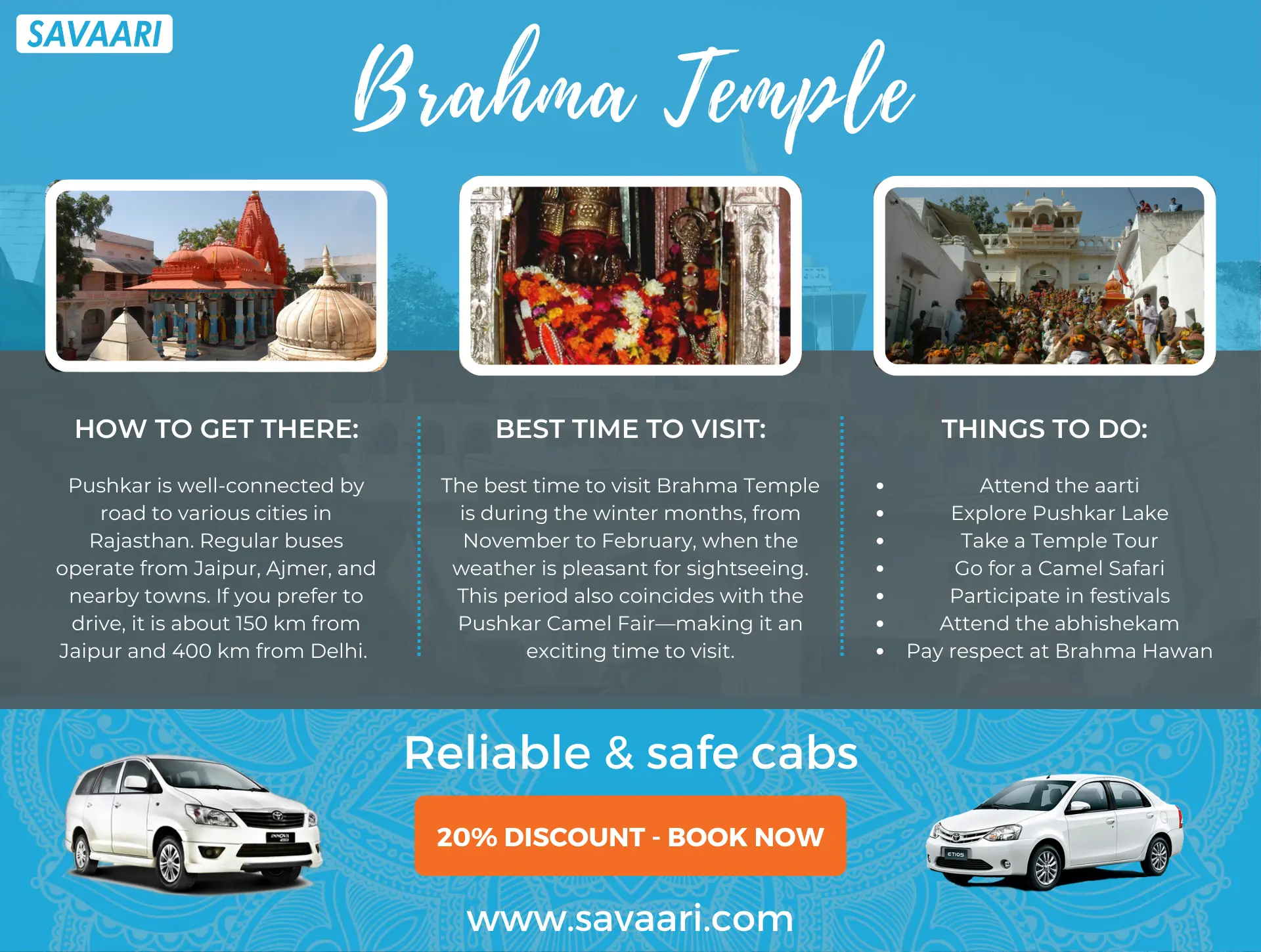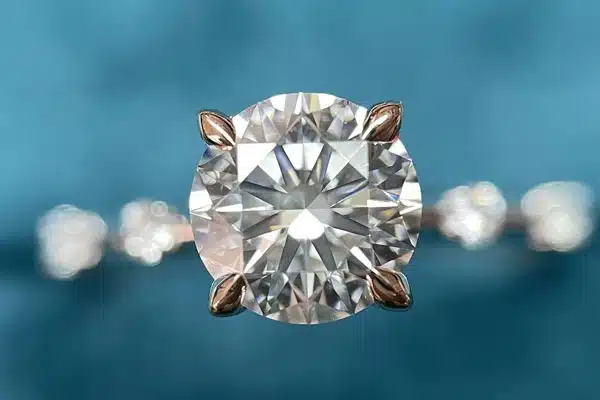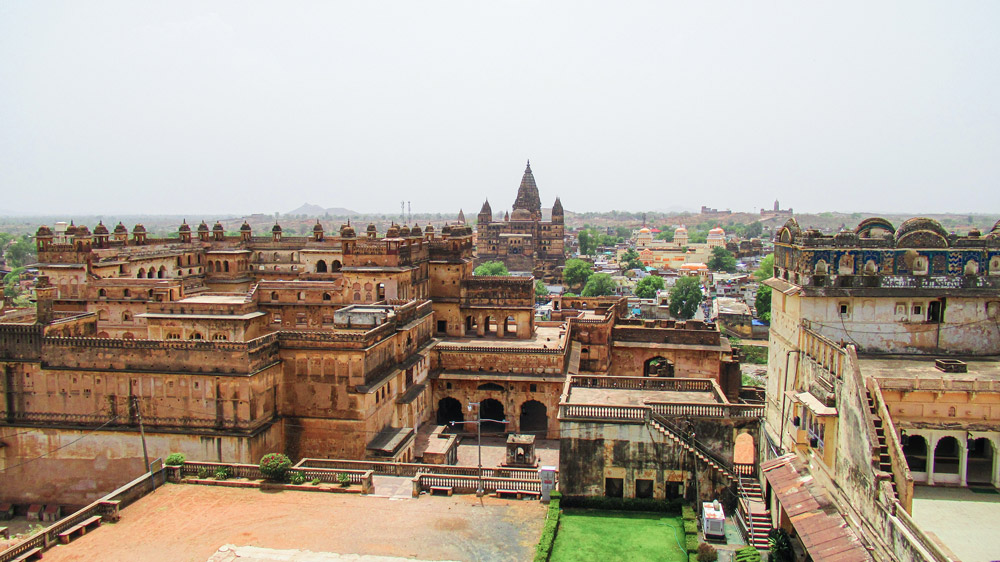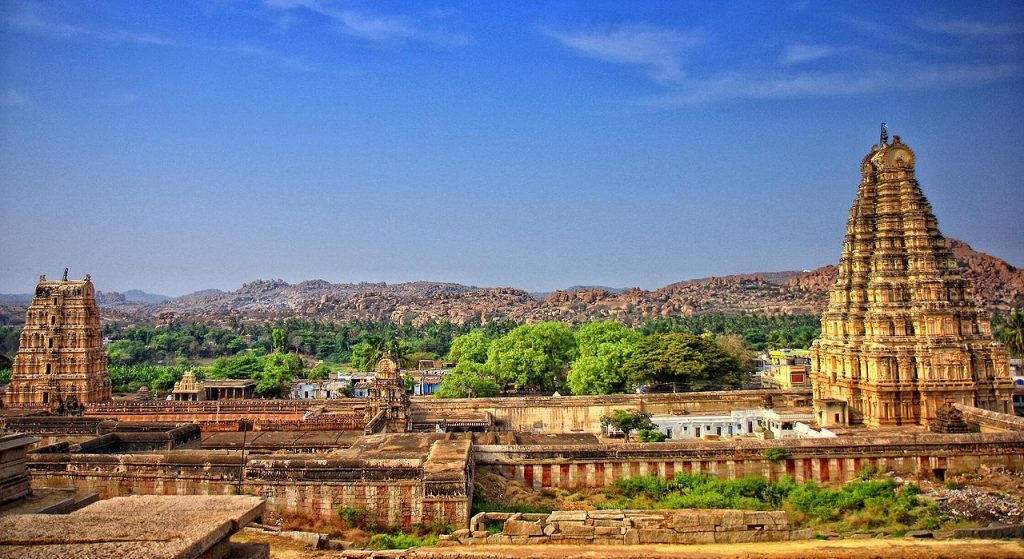The Jagatpita Brahma Mandir, more commonly known as the Brahma Temple, is a famous Hindu temple in the Rajasthani town of Pushkar. It is considered rare because it is one of the very few temples dedicated to Lord Brahma, the Hindu god of creation. Located in the lap of the Aravalli Hills, Pushkar is 15 kilometers away from the city of Ajmer.
The temple is located on the banks of the sacred Pushkar Lake and plays host to the vibrant and pious annual Pushkar Camel Fair. The deity and the temple structure are believed to have been built by the legendary Sage Vishwamitra. You can visit this temple by booking a car rental in Pushkar with Savaari and enjoy a pleasant ride. This guide to things to do in Brahma temple, Pushkar, will provide you with all the necessary information and details to plan a trip to this sacred place.
Table of Contents
- About Brahma Temple, Pushkar
- Things to Do in Brahma Temple, Pushkar
- Festivals at Brahma Temple, Pushkar
- Places to Visit Near Brahma Temple, Pushkar
- Places to Eat Near Brahma Temple, Pushkar
- How to Plan a Trip to Brahma Temple, Pushkar
- How to Reach Brahma Temple, Pushkar
- Hotels and Resorts in Brahma Temple, Pushkar
- Highest Road Trips Taken from Brahma Temple, Pushkar
- Useful Links
About Brahma Temple, Pushkar
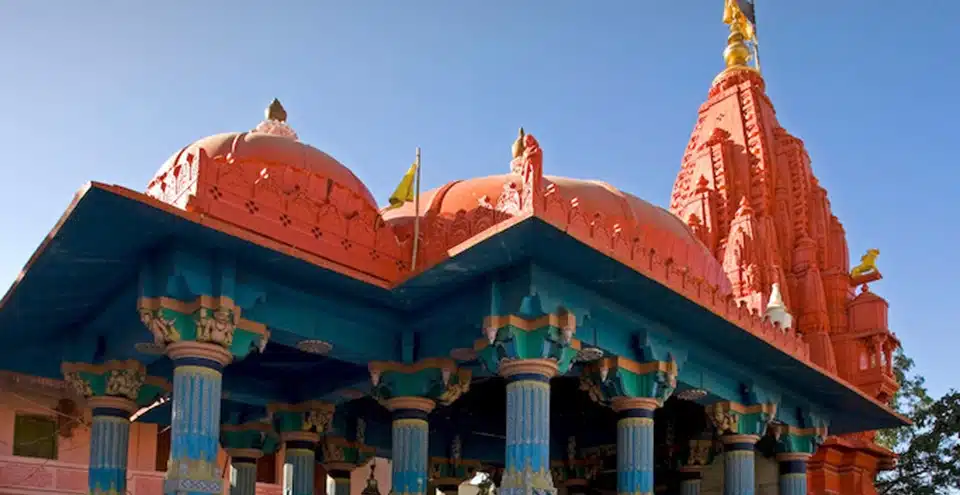
The Brahma Temple in Pushkar is believed to be about 2000 years old. Along with the sacred Pushkar Lake, it constitutes the “Rose Garden of Rajasthan.” The town is known for its quintessential Rajasthani scenes and vibes, from temples and markets to lakes and heritage sites.
Pushkar’s Brahma Temple: History
Pushkar is home to over 500 temples, including 80 large temples and many shrines (rebuilt from the ones destroyed during Mughal emperor Aurangzeb’s rule). The ‘garbagriha’ of the central Brahma temple—made of stone and marble slabs—dates back to the 14th century. The structure is believed to have been built by the legendary Sage Vishwamitra. Adi Shankara renovated it, and Maharaja Jawat Raj of Ratlam modified the current structure.
The temple features a shikhara (or tapering temple top) painted red with a captivating Hansa (swan) motif. Pushkar Lake and the Brahma Temple are among the ten most religious sites globally and one of the five sacred pilgrimage places for Hindus.
Deity of Brahma Temple, Pushkar
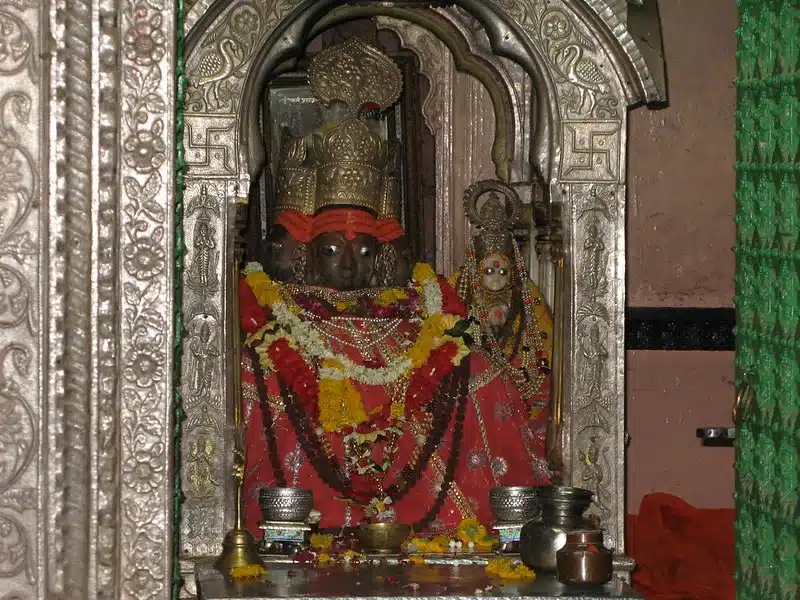
The Brahma Temple in Pushkar is dedicated to Lord Brahma, the creator of the universe according to Hindu mythology. Brahma is one of the deities of the Holy Trinity in the Hindu pantheon—alongside Vishnu, the preserver, and Shiva, the destroyer.
The temple’s Brahma idol is made of marble. It depicts the deity with four heads (symbolizing the four Vedas), sitting in a cross-legged position. The idol also includes his consort Gayatri, the Goddess of the Vedas.
Best Time to Visit Brahma Temple, Pushkar
The best time to visit Brahma Temple is during the winter months, from November to February, when the weather is pleasant and ideal for sightseeing. This period also coincides with the Pushkar Camel Fair—making it an exciting time to visit.
Pushkar’s summers are extremely hot, often exceeding 40°C; they should be avoided at all costs. The monsoon season from July to September brings moderate rainfall, but the town remains less crowded—offering a peaceful experience.
Lesser–known Facts About Brahma Temple, Pushkar
Some lesser-known facts about the Brahma Temple in Pushkar, Rajasthan, are:
- Pushkar Lake is said to have been formed from a petal of Lord Brahma’s lotus, which indelibly links it to the temple.
- The ancient scriptures refer to Pushkar Lake as “Tirtha-Raj,” which means the king of sacred water bodies. Fifty-two bathing ghats for pilgrims surround it.
- The Brahma Temple’s garbhagriha holds Lord Brahma’s image and his consort, Goddess Gayatri (not Sarasvati). This is unusual for Brahma temples.
- The Brahma Temple, Pushkar, hosts a grand festival on Kartik Poornima. The event sees great participation from sanyasis and attracts thousands of devotees each year from all over the world.
- Pushkar Lake and the Brahma Temple are considered one of the ten most religious places globally and one of the five sacred Hindu pilgrimage sites.
Darshan Timings at Brahma Temple, Pushkar
Knowing the darshan timings at the Brahma Temple helps you experience the temple’s spiritual ambiance at its most sacred moments. The temple’s schedule provides visitors with multiple opportunities to participate in aartis, darshans, etc., and seek blessings.
| Darshan Type | Morning Timings | Evening Timings |
| General Darshan | 5:30 AM–1:30 PM | 3:00 PM–9:00 PM |
| Mangal Aarti | Before Sunrise | 5:30 AM–6:00 AM |
| Sandhya Aarti | After Sunset | 6:30 PM–7:30 PM |
| Special Pujas | 7:00 AM–9:00 AM | 7:00 PM–8:00 PM |
Things to Do in Brahma Temple, Pushkar
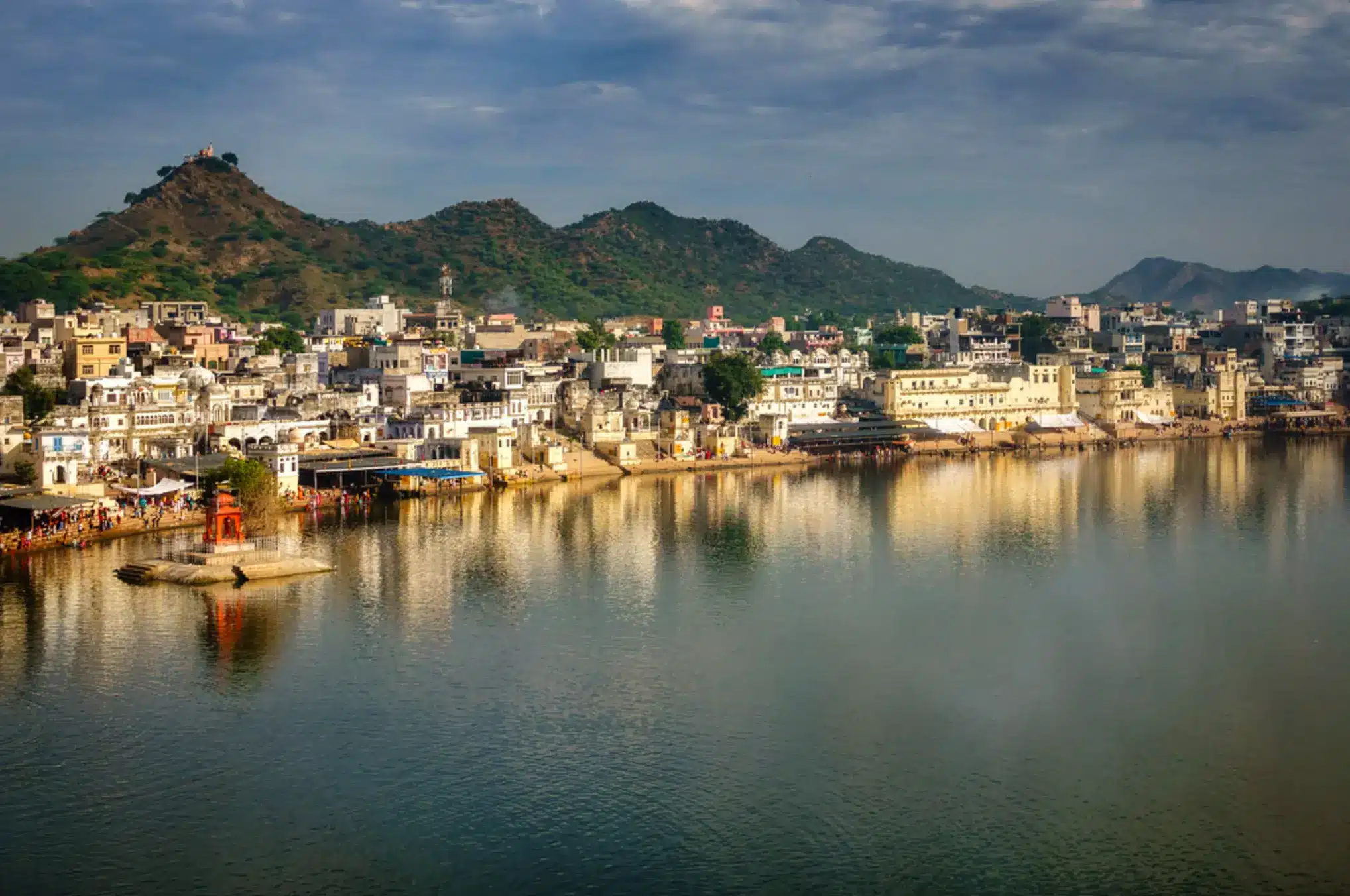
There are several things that tourists or devotees can do in Brahma Temple:
- Attend the Aarti: Devotees can attend the daily aarti (prayer ceremony) at the famous Brahma Temple. It’s a peaceful and spiritual experience with rituals that uplift the mood and the soul.
- Entry Fee: Nil
- Timings: 6 AM–9 PM (Summers) and 6:30 AM– 9:30 PM (Winters)
- Open Days: 7 days a week
- Explore Pushkar Lake: Devotees visiting the Jagatpati Mandir should take a dip in the Pushkar Lake. This activity is believed to cleanse sins and bring good fortune, and it is a must for pilgrims and visitors.
- Entry Fee: Nil
- Timings: 9 AM–6 PM
- Open Days: 7 days a week
- Take a Temple Tour: Devotees should also visit temples like the Savitri Temple, the Varaha Temple, and the Pap Mochani Temple. Each has a unique history and significance, enriching one’s spiritual journey.
- Go for a Camel Safari: Take a camel safari in the surrounding desert. This unique adventure offers stunning views of the Thar Desert and is a fun way to explore the beauty and simplicity of Rajasthan.
- Price: INR 800/person (1 hour). Prices may vary.
- Timings: Open 24×7
- Open Days: 7 days a week
- Participate in Festivals: Visit the Pushkar Camel Fair to enjoy vibrant festivities. The livestock and cultural festival mostly overlaps the months of October and November. Experience cultural performances and exciting competitions. Explore lively market stalls filled with unique items.
- Entry Fee: Nil
- Pushkar Camel Fair 2024 (Date): 9/11/2024–15/11/2024
- Timings: 9 AM–5 PM
Brahma Temple, Pushkar: Dresscode
Even though there is no specific dress code for visiting the Brahma Temple, Pushkar, it’s essential to respect the sanctity of the temple and its customs. Here are some pointers to help you adhere to the dress code and make your visit comfortable:
- Wear a traditional uutfit: It is advisable to wear traditional Indian attire when visiting the Brahma Temple. Men can wear a kurta-pajama or dhoti, while women can choose sarees or salwar kameez.
- Avoid western wear: Avoid any kind of Western clothing, as it may not be appropriate for an Indian place of worship.
- Remove footwear: It’s customary to remove your shoes before entering the temple premises. You can store them in designated areas near the entrance.
Poojas and Sevas at Brahma Temple, Pushkar
The Brahma Temple is a spiritual hub where devotees connect with the deity through a series of unique poojas and sevas, including:
| Pooja/Seva Name | Significance | Timings |
| Mangala Aarti | Early morning prayers to seek Lord Brahma’s blessings, symbolizing the beginning of a new day and invoking divine grace. | Morning: 5:00 AM–6:00 AM |
| Sandhya Aarti | Evening prayers with lamps and incense, offering gratitude and seeking protection and blessings as the day ends. | Evening: 6:30 PM–7:30 PM |
| Abhishekam | Ritual bathing of the deity with sacred bathing ingredients, symbolizing purification and the removal of negativity. | Morning: 7:00 AM–9:00 AM |
| Brahma Havan | The fire ritual seeks prosperity, spiritual awakening, and the destruction of negative energies through the power of the sacred fire. | Morning: 9:00 AM–10:00 AM |
| Purnahuti | The culmination of rituals, marking the completion of specific sevas as well as symbolizing the fulfilment of vows and the attainment of blessings. | Morning: After Brahma Havan |
| Shodashopachara | Detailed worship with 16 offerings to Lord Brahma, encompassing all aspects of devotion and honor. | Morning: 10:00 AM–11:30 AM |
| Annadanam | Offering food to devotees and the needy, thereby promoting charity, compassion, and the importance of serving humanity. | Daily from 12:00 PM onwards |
Brahma Temple, Pushkar: Entry Fees and Pooja Charges
The Brahma Temple welcomes pilgrims and visitors—offering various rituals and poojas. Here’s a detailed breakdown of the costs:
Entry Fees:
- General Entry: Free for all.
- VIP Entry: Specific fees may be applicable for quicker access or special services.
Pooja Charges:
- Mangala Aarti: A morning ritual, costing approximately INR 100.
- Sandhya Aarti: An evening ritual, costing approximately INR 100.
- Abhishekam: Ceremonial bathing of the deity, costing approximately INR 200.
- Brahma Havan: Fire ritual dedicated to Lord Brahma, costing approximately INR 500.
- Shodashopachara: Ritual involving sixteen steps, costing approximately INR 300.
- Annadanam: Free food distribution, promoting charity and community welfare. Donations are voluntary.
- Prasadam Distribution: No specific charge; voluntary donations are encouraged.
Please note that these costs are approximate and may vary over time. Confirm the current charges before your visit to ensure a seamless experience.
Festivals at Brahma Temple, Pushkar
The Brahma Temple is a popular hub for festivals, attracting pilgrims and visitors from around the globe. Infusing the temple town with culture, devotion, and tradition, these celebrations include:
- Kartik Purnima (November): Celebrated during the full moon night of Kartik, the festival marks Lord Brahma performing a yajna at Pushkar. Pilgrims take a holy dip in Pushkar Lake and offer prayers at the temple.
- Navratri (September/October): The nine-night festival dedicated to Goddess Durga. The devotional festivities are also accompanied by cultural programs.
- Diwali (October/November): Diwali, the festival of lights, is celebrated here as lavishly as the rest of India. Devotees light lamps, perform special poojas, and participate in cultural programs.
- Holi (March): Rajasthani Holis are legendary and, resultantly, the festival of colors at Pushkar is celebrated on a grand scale. Devotees play with colors and participate in special rituals.
- Makar Sankranti (14th January): Celebrated with kite flying and special rituals, the Makar Sankranti festival marks the sun’s transition into the Tropic of Capricorn.
These festivals offer a chance to witness the rich tapestry of Indian culture and spirituality. Visiting the Brahma Temple during these festivals provides a unique and vibrant experience (besides great photo walks and street food) that reflects the deep-rooted traditions of Rajasthan.
Places to Visit Near Brahma Temple, Pushkar
Exploring the surrounding areas of Pushkar can enhance your trip, offering a deeper insight into Rajasthan’s cultural and historical richness. Here are some of the places to visit near Brahma Temple, Pushkar:
Pushkar Lake
Considered one of the most sacred lakes in India, Pushkar Lake is surrounded by 52 ghats (stone staircases). Pilgrims take a holy dip in the lake, believing it cleanses sins and brings good fortune. The lake is also a hub of activity during the Pushkar Camel Fair. This annual camel-trading festival is a cultural extravaganza. Devotees and tourists attend the festival to enjoy folk music and dance performances, camel race activities, and more. The fair also attracts visitors by hosting handicraft, textile, and jewelry shops.
- Timings: 9 AM–6 PM
Savitri Temple
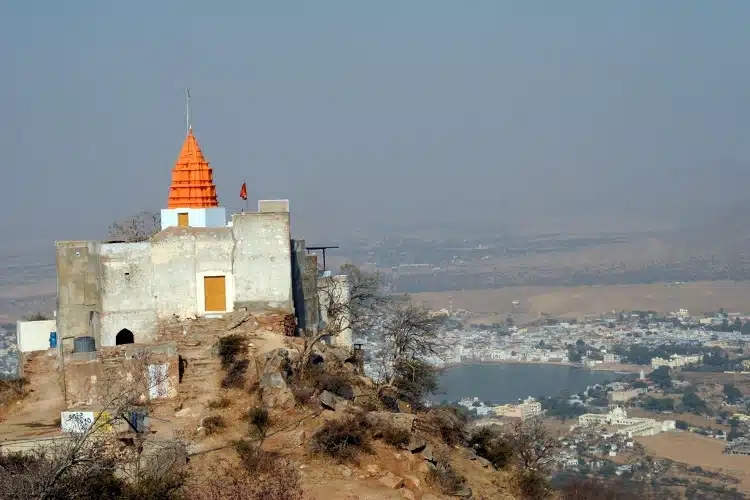
Located on a hilltop, the Savitri Temple is dedicated to Lord Brahma’s wife, Goddess Savitri. A trek up the hill provides panoramic views of Pushkar and the surrounding desert.
- Timings: 5 AM–12 PM and 4 PM–9 PM
Varaha Temple
This ancient temple is dedicated to Lord Vishnu’s avatar, Varaha (the boar). It is one of the oldest temples in Pushkar and is known for its intricate carvings and serene atmosphere.
- Timings: 6 AM–12:30 PM and 4 PM–8 PM
Pap Mochani Temple
Dedicated to Ekadashi Mata, this temple is believed to absolve sins with blessings. It is located on a hill and offers a peaceful retreat from the bustling town below.
- Timings: 6 AM–7 PM
Rangji Temple
This temple is unique for its blend of South Indian, Mughal, and Rajput architectural styles. It is dedicated to Lord Rangji, who is considered to be an incarnation of Lord Vishnu.
- Timings: All day long
Ajmer Sharif Dargah
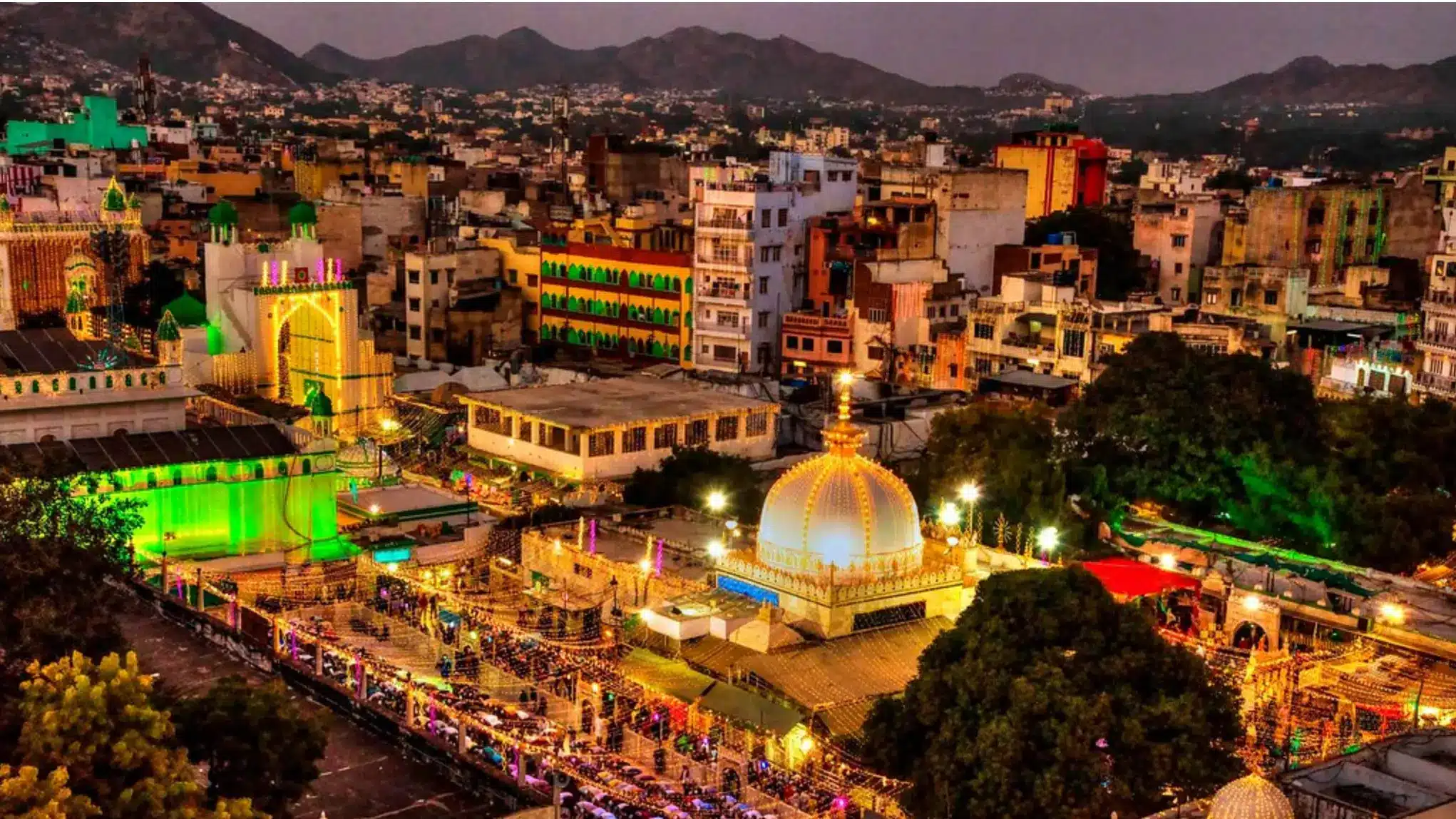
Located about 15 km from Pushkar, the Ajmer Sharif Dargah is a famous Sufi shrine dedicated to Khwaja Moinuddin Chishti and one of the most popular places to see in Ajmer. It attracts pilgrims of all faiths from across the world.
- Entry Fee: Nil
- Timings: Open 24×7
- Open Days: 7 days a week
Ana Sagar Lake
Ana Sagar Lake is an artificial lake in Ajmer, popular for boating and picnics. The nearby Daulat Bagh gardens offer a pleasant place for a stroll.
- Entry Fee: Nil
- Timings: Open 8 AM–8 PM
- Open Days: 7 days a week
Taragarh Fort
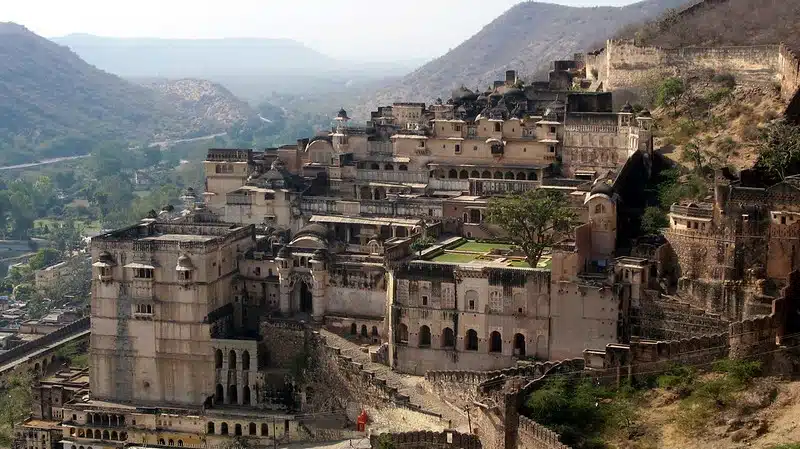
This ancient fort in Ajmer offers a glimpse into Rajasthan’s rich history. The fort provides panoramic views of Ajmer city and is known for its impressive architecture.
- Entry Fee: INR 100
- Timings: Open 24×7
- Open Days: 7 days a week
Merta City
About 50 km from Pushkar, Merta City is known for its historical and religious significance. It houses the Meera Bai Temple, which is dedicated to the famous bhakti poet and saint Meera Bai. She was a devotee of Lord Krishna, and her kirtans are extremely famous.
Places to Eat Near Brahma Temple, Pushkar
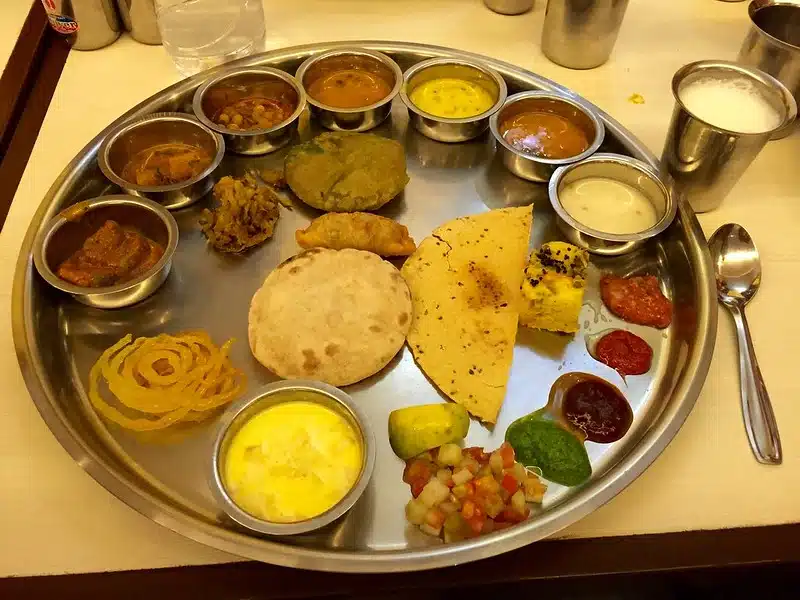
Pushkar’s culinary scene is diverse and caters to all tastes and budgets. Here are some of the popular places to eat in Pushkar:
- Raju Terrace Garden Restaurant, Main Market Road: Known for its traditional Rajasthani thali, this restaurant offers a cozy garden setting and a relaxed atmosphere.
- Honey & Spice, Laxmi Market : This cafe is popular for its healthy and delicious vegetarian dishes. It’s a favorite among travelers looking for nutritious meals and a welcoming ambiance.
- Sunset Cafe, Choti Basti: Located by Pushkar Lake, this cafe offers stunning views and a variety of dishes, including Indian, Italian, and Continental options. It’s a perfect spot for a meal with a view.
- Out of the Blue, Brahm Chowk: Known for its eclectic menu and laid-back atmosphere, this restaurant is a great place to relax and enjoy a meal. The menu includes Indian, Continental, and Israeli dishes.
How to Plan a Trip to Brahma Temple, Pushkar
Planning a trip to Brahma Temple, Pushkar, involves a few key steps. Book your accommodation in advance, especially during the Pushkar Camel Fair. You can choose from several accommodation options ranging from budget hotels to luxury resorts. Create an itinerary that includes temple visits, exploring local markets, and sojourning through nearby attractions while leaving free time to relax.
Plan your transportation well. Enjoy local Rajasthani cuisine at popular eateries, and take care to include spiritual, cultural, and adventurous activities like the temple aarti, camel safaris, and yoga sessions into your trip for an immersive and unforgettable experience.
How to Reach Brahma Temple, Pushkar
Pushkar is easily accessible via different transportation modes:
By Train
The nearest railway station to Pushkar is Ajmer Junction, which is well-connected to major cities like Delhi, Mumbai, and Jaipur. From Ajmer, Pushkar is a 30-minute drive, and you can easily hire a taxi service from Ajmer to Pushkar with Savaari. Trains like the Shatabdi Express and the Rajdhani Express connect Ajmer to major cities, making it a convenient option for travelers.
By Road
Pushkar is well-connected by road to various cities in Rajasthan and beyond. Regular buses operate from Jaipur, Ajmer, and other nearby towns. If you prefer to drive, Pushkar is about 150 km from Jaipur and 400 km from Delhi. Book a comfortable cab service from Jaipur to Pushkar with Savaari Car Rentals or from nearby cities like Delhi, Jodhpur, etc., for a comfortable experience. The roads are well-maintained, and the drive offers scenic views of the Rajasthani countryside.
By Flight
The nearest airport to Pushkar is the Jaipur International Airport, about 150 km away. From the airport, you can hire an airport taxi in Jaipur with Savaari to reach Pushkar. Jaipur has good connectivity with major cities across India, with regular flights being operated by various airlines.
Hotels and Resorts in Brahma Temple, Pushkar
Pushkar offers a range of accommodation options, from hotels to resorts, that suit all budgets and preferences. Here are some of the best hotels and resorts in Pushkar:
| Hotel Name | Address | Phone Number |
| The Pushkar Bagh | Railway Station, Motisar Link Road, Ghanehera, Pushkar – 302055 | 94140 30669 |
| Hotel Brahma Horizon | Panch Kund Road, Pushkar – 305022 | 81070 44285 |
| Ananta Spa & Resorts | Leela Sevri Village, Dev Nagar, Pushkar Road, Pushkar – 305022 | 0141 354 0500 |
| Green Park Resort | Bus Station, Vaam Dev Road Pushkar – 305022 | 97993 47220 |
| Hotel Pushkar Palace | Near Pushkar Lake, Choti Basti, Pushkar – 305022 | 98280 60601 |
A visit to the Brahma Temple in Pushkar is a journey of spirituality, culture, and natural beauty. Whether you are a devotee seeking blessings, a traveler exploring new places, or an adventurer looking for unique experiences, Pushkar offers something for everyone. This travel guide to Pushkar provides all the information you need to plan and enjoy a memorable trip to this enchanting town.
Highest Road Trips Taken from Brahma Temple, Pushkar
Even though Pushkar is a city that is worth exploring on its own, it does offer travel enthusiasts an opportunity to explore some nearby and famous places in Rajasthan. Some of the popular destinations that you can travel to from Brahma Temple, Pushkar, are:
| Destination | Distance by Road (approx.) |
| Brahma Temple to Jaipur | 141 km |
| Brahma Temple to Jodhpur | 180 km |
| Brahma Temple to Udaipur | 278 km |
| Brahma Temple to Mount Abu | 378 km |
| Brahma Temple to Jaisalmer | 460 km |
Download the Savaari mobile app to explore the best routes and get the best deals on cabs and rentals for a road trip from Pushkar.
Useful Links
Last Updated on December 16, 2024 by V Subhadra



